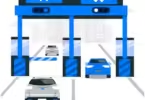If you asked real estate agents and home builders in the late spring how buyers were responding to the pandemic, they would answer with tales of multiple home offices and private gyms becoming must-haves.
But as the virus surged into winter, less sexy – but more important — components like air-filtration systems and new approaches to a condo building’s package drop-off zone were suddenly entering the conversation.
Covid-19 proof building design idea
With Covid-19 in daily headlines, the majority of us are staying home enjoying the space we live in. Home has to serve work, school and recreation all rolled into one building.
I am seen various design trends over the years from multi-generational living, increase in smart technology, global warming and sustainability. Our designs have evolved to accommodate residential and commercial buildings. This pandemic has challenged us to consider the “wellness environment” in a new light.
Panic rooms, fire shelters and bunkers have come about in response to society challenges, may the need for a virus proof house be next? Hospitals have negative pressure rooms for isolation and sterile surgical theatres. With time, could these become economically viable for the home? Could a zone within a house become pressurized with the switch of a button?
How to Design Virus Proof Spaces?
What is the danger? It seems over-cooled spaces can be conducive for virus survival and spread through surface contamination. We do not know much about this yet. Does this have implications for the way we are designing the buildings?
Common measures currently in play in spaces include using a mud room as an entry point, removing footwear, considering materials with minimal joints and easy clean surfaces and well-ventilated rooms throughout. Today there are also many self-cleaning or anti-bacterial surfaces and materials which can be specified in the build.
In short, designing one’s environment to reduce the threat of exposure, enhance our daily living and provide security whilst considering the sustainable impact of our planet is a challenge for the creative, innovative and well-informed architect.
Measures to be Take
If we continue to design thermally uncomfortable buildings with poor ventilation, inadequate shading and high heat loads on the structures, number of days and hours requiring mechanical cooling or air conditioning will continue to increase.
Climate change and heat waves will worsen this. An assessment by the Centre for Science and Environment (CSE) shows how electricity consumption spirals out of control when heat index increases during summer in Delhi. While cooling can protect under extreme heat conditions, it also has other health and energy security concerns. COVID-19 is reminding us that.
Most Indian homes are naturally ventilated in which people can control wind and sun with windows, openings and shading. When these are shut off to make the air conditioners work, rates of building ventilation with outdoor air gets reduced.
Closed windows in naturally ventilated buildings increase the indoor air concentrations, pollutants and the air conditioning system itself becomes sources of microbial contaminants.
Crux
While “COVID-proofing’’ is a term said somewhat wistfully, it hasn’t stopped architects and home builders from accelerating healthy-living trends that were already growing in popularity before the pandemic.
Enhanced water- and air-filtration systems and a general push toward sustainability are increasingly basic expectations in both the single-family and multifamily home sector.
These healthy-living trends – particularly in the realm of air filtration – are on track to be a new standard of post-pandemic home building.
The logic seems simple – if we do not design buildings for improved thermal comfort and to reduce the air-conditioned hours, higher dependence on excessive cooling can create another trap for us – safe havens for deadly viruses. If the scientific community is already talking about this, this needs further investigation.
Do you have a thoughts on this subject, please share in comments below…








Leave a Comment
You must be logged in to post a comment.